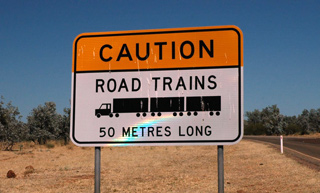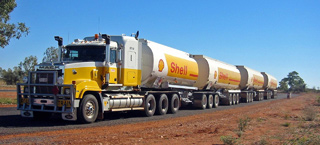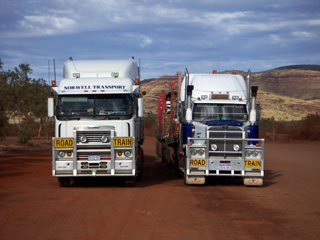 Newspaper about trucks, cars, and ground transportation. Published monthly and distributed in Greater Toronto Area, Montreal, Winnipeg, Calgary and Vancouver.
Newspaper about trucks, cars, and ground transportation. Published monthly and distributed in Greater Toronto Area, Montreal, Winnipeg, Calgary and Vancouver.
Some Light at the End of the Tunnel for Senior Truck Driverss
MTO agrees licence renewal system can be less onerousToronto - In a letter to the Ontario Trucking Association, the province's Minister of Transportation, Bob Chiarelli, says the government agrees "that commercial driver licence renewal can be made less onerous for senior drivers (drivers 65 years of age and older) without compromising safety" and has asked his parliamentary assistant, Vic Dhillon (MPP, Brampton West) to lead a review to determine what amendments to the renewal requirements are needed and a plan to implement them.
OTA and MTO have been discussing this issue for the past few years and the association is optimistic that a mutually agreeable and beneficial solution is attainable in the short-term. David Bradley, OTA's president said "the minister is sending the signal that the government is willing to make some changes and given the discussions we have had with the ministry to date, we don't think we are very far apart in terms of what should and can be done."
"We are eager to work with Mr. Dhillon early in the New Year to help establish the policy," says Bradley. "We recognize there will be a regulatory process that has to be followed and that implementation will require system changes and the like, but we hope that by this time next year senior truck drivers in Ontario will be subject to a much fairer and less burdensome licence renewal process."

The Country of Road Trains
This article about truckers of Australia has been written by Australian journalist Tina Vasilieva and was shared with us by colleagues from Australian Almanac.
This article about truckers of Australia has been written by Australian journalist Tina Vasilieva and was shared with us by colleagues from Australian Almanac.
The Country of Road Trains
Full freedom is full solitude

The loneliest job in the world this is a popular definition of the U.S. President's post. While doing this job, one distances oneself from friends and relatives and becomes lonely. They say that William Howard Taft, when handing over the power to Woodrow Wilson, said "I'm glad to be going--this is the lonesome's place in the world."
Perhaps it is true. However, there are people who would argue with the U.S. President with regard to the notion of loneliness. They are Australian long-haul truck drivers who spend 24 hours a day on their own in a truck cabin, and sometimes they talk to their friends and family on the phone.
Australia is a country of road trains. In the depth of Australia, where you will only find one or two livestock farms, or stations, per hundreds of kilometers, road trains are a vital necessity. In order to deliver goods to the destination by a railroad train, the owner, for example a sheep station, would have to make several hundreds of kilometers with their livestock until the nearest railroad station.
Road trains are powerful tow-cars pulling two, three (and sometimes more) huge trailers and capable of crossing the green continent in just a few days. They connect the country's states and territories which are thousands kilometers apart from one another.
Modern road trains, which have long ago become road masters, are quite comfortable. Most drivers have a conditioner in the cabin (which is not that bad in a 40-degree heat), a small fridge and even a sleeping place. Life behind the steering wheel is simply about three things: eating, sleeping and driving. There is one major rule on the road: sleep as little as you can, arrive at your destination as soon as possible. "The only thing you are worried about is how not to fall asleep while driving," says Ian Conway, who has traveled across Australia in the cabin of his truck. It is truly difficult to fight with the many days of fatigue. "Measuring the distance in beer cans is a usual thing," remembers Ian who has traveled across the country delivering furniture and home appliances "six cans of beer is nothing special, but a 12 beer can road is quite a distance." Such a measurement unit is common not only for driver, but for the police, too. "If you have committed a crime," reads a humorous story about Tennant Creek, "consider this: the police car will await you no further away from the crime scene than 12 beer cans (the amount of time one needs to drink a dozen of beer cans is the distance measurement unit used in this area)."
All kinds of things happen. Some drivers cannot stand it and begin to take various stimulants. Some stock up with several cases of beer and drink one can after another on the road. But it is seldom. The majority do not allow themselves to relax and let their guard down for a second. They prefer a different measurement unit - cans of coca cola. In Australia there are strict laws with regard to drinking and driving.
An endless road

Would it be possible to measure the distance in cups of coffee? Turns out it is possible. In the Northern Territory, as opposed to other states and districts, life almost completely depends on huge road trains with three and more trailers, which can transport up to 115 tons of load. In this part of the country you may come across road trains consisting of 7 trailers and capable of carrying up to 190 tons of load.
Even since a railroad connected the cities of Alice Springs and Darwin, road trains have remained the major means of transportation between the cities in the south, while also connecting Darwin to the rest of the Northern Territory. This is why ensuring safety on the roads is a priority for the local administration.
One of recent novelties is a program "Coffee Break Stay Awake!" which helps to fight the inevitable fatigue due to the driver's many monotonous and tiring hours behind the steering wheel. Now every driver has a map showing all gas stations and road houses where a driver can get a free cup of coffee. Every truck stop like that is decorated with a large bright sign reading that you can expect a short break, a hot meal and free tea or coffee.
Another feature of local roads from time to time on the roadside one can notice a loading bay with a "stack" of empty trailers. Such bays are common on major roads. Deeper in the country they are usually replaced by an earth or gravel fill. In order to prevent a wheel slip, they often use the diff lock system. One may also often see lonely empty trailers along the roadside. Such a trailer is waiting to be picked up by the driver on the way back, and for the time being there is no need to worry about it, no one will steal it.
A short break, and back on the road again. The compressed-air starter is roaring, the frame of the Kenworth truck, an indisputable master of Australian deserts, is shaking, the engine is uttering such a roar that ear drums are about to burst. The truck is taking off and disappearing in the clouds of red dust, running many kilometers through a deserted endless road.
Most often you may see American trucks Kenworth on the roads, and they are no doubt leaders on the Australian market. These trucks only have one significant competitor Mack an American company as well, which has served the Australian market for over 40 years. At the same time there are other truck brands on the roads: Ford, Canada's Western Star, Europe's Volvo, Scania, Renault and others. However, their share on the Australian truck market is not significant. Constant serious competition is only seen between Kenworth and Mack. "It is a lot like comparing Sidney to Melbourne the two cities are competing all the time," Ian is answering to my question with regard to the most popular brand in Australia.
In general, Australian tractor trucks are different from all others in the world, even if the brand is the same. Local Kenworth and Mack trucks are assembled in Australia. "Americans" are simply not equipped to work in these conditions; they are designed for a different kind of workload and would not be able to survive here for a long time.
There are several main types of road trains, and the first one is an A-train, which includes dollies. It consists of a tractor and a semi-trailers; the first semi-trailer is leaning on the tractor and others on dollies. The second type, a B-train, includes a short semi-trailer with a standard seat at the rear supporting the next semi-trailer.
Finally, the third type, a C-train, is not to be seen here. Just like an A-train it includes two dollies but a C-dolly is connected to the front trailer by two beams creating an inflexible connection. C-Dolly is not allowed to be used in Australia.
Road train champions of the world

In 1999 the town of Merredin in Western Australia made it into the Guinness Book of Records. Company Marleys Transport decided to create the longest road train in the world. The attempt was a success, and driver Greg Marley, sitting behind the steering wheel of a Kenworth K100, proudly pulled 45 trailers weighing 603 tons and 601 meters long for eight kilometers.
A year later the town of Kalgoorli in Western Australia set a new record. Five thousand spectators observed a train with 78 trailers 1018 m long weighing 1072.3 tons pulled by Kenworth C501T with Stephen Matthews behind the steering wheel. It successfully took off and overcame the required 8 km distance, having run 8.127 km.
This record held up until 2003 when close to Mungindi in New South Wales a new record was set: this time a road train consisted of 87 trailers and it was 1235 meters long.
A new record set by the state which is famous for its longest road trains in the world was not late in arriving, and it happened once again in the gold mining centre of the state in Kagoorli. The train was 1442 meters in length.
And finally, quite recently, in 2006 in Clifton (state Queensland) a new world record was registered, where a tractor ran the required distance pulling 104 semi-trailers (1474,3 meters long).
A road connecting the states of South Australia and Western Australia is especially deserted and lonely. There is not a single roadside cafe or a gas station for hundreds of kilometers. They are not needed though Mack's fuel tank can hold up to 2000 liters of fuel. The road is perfectly straight without a single curve, and is unwinding like an endless ribbon. A driver will be lucky to see a lonely tree on this flat plain. In such circumstances it is difficult not to lose the sense of reality and not to fall asleep behind the steering wheel.
The road train roars eating away the space, and nothing can stop it, it fears no obstacles, and you'd better not come across this giant.
White deflector plates, mounted in a row on the upper part of the wind shield, are perfectly visible in the dark. An oncoming vehicle's driver understands long before the encounter, what kind of a beast is approaching them. They know: it is better to take foot off the gas and pull over, otherwise the car will risk being blown away from the road by the oncoming air flow.
To protect the glass from stones, the wind shield is covered by a protective net a stone guard. Stones are not the only danger, another risk is when you drive in a caravan and a protector on the truck in front of you blows up. Just like a bomb, this smashing blow can shatter the wind shield of the following truck.
There is one more danger, it is lurking until a tractor speeding along with huge trailers comes across animals on the road. In this case a radiator and a cabin are protected by a roo-bar. Kangaroos are least harmful animals but cows or sheep standing right in the middle of the road are a different story. Various stations along the road, spread out in the outback, occupy territories as large as some smaller European countries. Each station stretches for hundreds of square miles, and many farmers use helicopters to gather pasturing cows or sheep. Clearly, such a pasture cannot be enclosed with a fence. However, even an animal as large as a cow is now very dangerous for a truck. "But if there are three of them on the road, hold on," says Ian, "it especially gets on your nerves in South Australia, on a hilly terrain, where the view is not that good." Below a roo-bar, or a bull-bar as truckers prefer to call it, they install cow-catchers, like on railroad locomotives. They don't let poor animals to go under the truck bed, otherwise the truck could overturn.
There is not a chance for a road train to brake on time when it comes across an obstacle on the road. In case of emergency braking, considering the weight and the speed of over 100 km/hour, the road train will 'plow' another kilometer of the road, leaving behind deep trenches. Such a truck is not created for braking; its goal is to race, crossing the continent within a few days without stopping.
We should mention that Australian road trains have an interesting brake system. It is not without reason that they are called road trains their brake system resembles that of railroad trains.
Compressed air brakes are the main type of brakes on road trains. The use of fluid brakes is practically impossible in such systems. Compressed air brakes allow to combine the usual foot brake system with the emergency system, which uses both common brakes and a parking brake. The air compressor brought into action by the main engine of the truck, pumps air into special reservoirs. The pressure control manages the compressor, switching it off when the pressure reaches maximum allowed level (usually 900 Kpa), and switching it on when pressure falls below minimal level (usually 590 Kpa). The number and the capacity of reservoirs for compressed air varies among tractors. The capacity should be sufficient for multiple use of the brake, even if the compressor stops functioning. Tractors hauling long road trains usually have additional reservoirs installed.
The use of compressed air allows to easily connect a tractor with trailers, while enabling the trailers to brake, and for all the brakes to be managed in the truck cabin. The tractor's brake system is designed to keep functioning even if a trailer breaks away. In essence, the system ensures all three types of brakes: a foot brake where the driver pulls the foot brake and all wheels brake; a parking brake, and in addition, an emergency brake. The foot brake presses and releases brake blocks when the brake pedal is in use.
The parking brake system is operated by a brake lever. Parking brakes are activated by springs. And finally, the emergency brake system employs both foot and parking brake systems to stop the road train of the foot brake stops functioning.
The one who risks, loses

Occasionally, a similar powerful road train monster with several huge trailers passes by in the opposite direction. The giants greet each other with a loud honk and disappear in the clouds of red dust. Considering the speed of 100-110 km/hour they only have a second for this friendly gesture. A second is a lot. A usual five meter long car will flash, like a butterfly behind the window; you won't even notice, let alone greet it. And the driver will have the only concern to hold on tight to the steering wheel so that the car does not get blown away from the road.
Adrenaline buzz is even stronger if you decide to pass such a road train. It is quite a risky maneuver, as in line with the law of aerodynamics the car will be moving towards the side of the road train.
Stirling Highway, a 3000 km highway connecting the country's north and south, Darwin and Adelaide, is a straight two-way single lane road. Australian truckers complete this route at a high speed within 5.5 days, covering the distance of 800-900 km a day. The road trains on this highway demand respect. In most European countries, average length of the train is18.5 meters (it is not even considered a road train in Australia). Just recently they allowed to operate 25.25 meter long road trains in Finland and Sweden. In Australia, a double road train weighing 80 tons is about 35 meters long, while a triple road train weighs up to 115 tons and is 53-56 meters long. Passing such a vehicle is like taking the risk of passing ten vehicles. To give credit to truck drivers, most of them are professionals, considerate and courteous towards other road users. Their politeness is impressive. For example, if you are at a crossroad in a city waiting to turn left (traffic is left-handed in Australia), and on your right there is a giant truck with a trailer, upon noticing you the driver will smile, wave their hand at you and the groaning vehicle will back away for a couple of meters not to block your view. On a highway, if a road train driver notices a catching p car, they will move towards the roadside and begin to flash a turn signal showing when you can pass the road train.
All road trains are equipped with citizens' band ultra-short wave radios. It is extremely helpful in emergency situations: you can get in touch with a road train driver on the radio, and they will let you know when it is safe to pass.
The most dangerous venture is probably passing the famous triple trailer, the symbol of the Northern Territory. A 52-metre long road train moves at the speed of 100-110 km/hour. Add 75 metres the distance which should allow the passing vehicle to 'emerge' from behind the flying road train, and another 75 meters allowing to come back onto the road in front of the vehicle. The government of the Northern Territory notes in the recommendations issued for tourists that a driver who intends to pass a road train, moving at the speed of 100 km/hour, should be absolutely sure that the road is free for the next one kilometer stretch. If the road train's speed is 110 km/hour, the situation becomes even more dangerous the passing car should take the 'wrong' opposite lane for 1 minute 12 seconds and cover the 2,2 km distance while passing. Personal experience shows: there is only one way to decrease the passing time to move at the 140-150 km/hour speed, violating all the rules. However, the maneuver time will make up only 15-20 seconds.
Sometimes you happen to catch up with a super huge freight vehicle. It is always accompanied by other vehicles equipped with a radio. When you catch up with the escort vehicle's driver, they will communicate with the caravan members and give you a sign when it is safe to pass. Without such assistance it is very risky to pass this huge caravan. If you are afraid of following the signal, you will have to tag along and wait until the caravan stops for a minor inspection and brake check, which happens every 100 kilometers.
Freedom is solitude
What do you value most in your job? Most drivers will answer without hesitation: "The freedom, of course!" Kingsley Foreman from Adelaide, who has worked as a trucker for 25 years, expressed himself best of all. He described his profession as follows: "I enjoy solitude." I got used to relying on myself and my personal freedom is very valuable to me. And I am proud to be Australian."
Could it be considered a challenge for the U.S. President? I don't think it would worry the protagonists of our today's story. The person who is sitting in a cab of a powerful road train, roaring its way through the Green Continent, flying at the 100 km/hour speed, has the feeling of freedom which is quite different from that feeling of solitude experience by a person sitting in a chair of the most comfortable office in the world.





